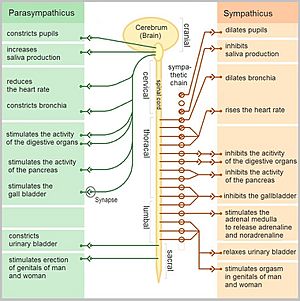Autonomic nervous system facts for kids
The autonomic nervous system (ANS) controls the conditions inside the body. It is sometimes called the 'visceral nervous system' or 'involuntary nervous system'. The ANS is part of the peripheral nervous system.
The Autonomic nervous system controls all automatic actions. That means most of its activities are done without the person having conscious control over them. The person usually cannot feel what the ANS is doing. However, some of the ANS's activities work together with the conscious mind, like breathing.
The Autonomic nervous system controls many different things, like heart rate, digestion, respiration rate, salivation, perspiration, diameter of the pupils and the discharge of urine.
There are two different sections within the ANS:
- The sympathetic nervous system, which causes the body to become more active as in the "fight or flight" response.
- The parasympathetic nervous system, which is mostly involved in "rest and digest".
Contents
Function
Sympathetic and parasympathetic divisions typically function in opposition to each other. Some typical actions of the sympathetic and parasympathetic nervous systems are listed below.
| Target organ/system | Parasympathetic | Sympathetic |
|---|---|---|
| Digestive system | Increase peristalsis and amount of secretion by digestive glands | Decrease activity of digestive system |
| Liver | No effect | Causes glucose to be released to blood |
| Lungs | Constricts bronchioles | Dilates bronchioles |
| Urinary bladder/ Urethra | Relaxes sphincter | Constricts sphincter |
| Kidneys | No effects | Decrease urine output |
| Heart | Decreases rate | Increase rate |
| Blood vessels | No effect on most blood vessels | Constricts blood vessels in viscera; increase BP |
| Salivary and Lacrimal glands | Stimulates; increases production of saliva and tears | Inhibits; result in dry mouth and dry eyes |
| Eye (iris) | Stimulates constrictor muscles; constrict pupils | Stimulate dilator muscle; dilates pupils |
| Eye (ciliary muscles) | Stimulates to increase bulging of lens for close vision | Inhibits; decrease bulging of lens; prepares for distant vision |
| Adrenal Medulla | No effect | Stimulate medulla cells to secrete epinephrine and norepinephrine |
| Sweat gland of skin | No effect | Stimulate to produce perspiration |
Sympathetic nervous system
Promotes a fight-or-flight response, corresponds with arousal and energy generation, and inhibits digestion.
- Diverts blood flow away from the gastro-intestinal (GI) tract and skin via vasoconstriction
- Blood flow to skeletal muscles and the lungs is enhanced (by as much as 1200% in the case of skeletal muscles)
- Dilates bronchioles
- Increases heart rate
- Dilates pupils and relaxes the ciliary muscle to the lens, allowing more light to enter the eye and enhances far vision
- Constricts all the intestinal sphincters and the urinary sphincter
- Inhibits peristalsis
Parasympathetic nervous system
The parasympathetic nervous system has been said to promote a "rest and digest" response, promotes calming of the nerves return to regular function, and enhancing digestion. Some functions of nerves within the parasympathetic nervous system include:
- Dilating blood vessels leading to the GI tract, increasing the blood flow.
- Constricting the bronchiolar diameter when the need for oxygen has diminished
- Constriction of the pupil
- Stimulating salivary gland secretion
Enteric nervous system
The enteric nervous system is the intrinsic nervous system of the gastrointestinal system. It has been described as "the Second Brain of the Human Body". Its functions include:
- Sensing chemical and mechanical changes in the gut
- Regulating secretions in the gut
- Controlling peristalsis and some other movements
Images for kids
See also
 In Spanish: Sistema nervioso autónomo para niños
In Spanish: Sistema nervioso autónomo para niños




